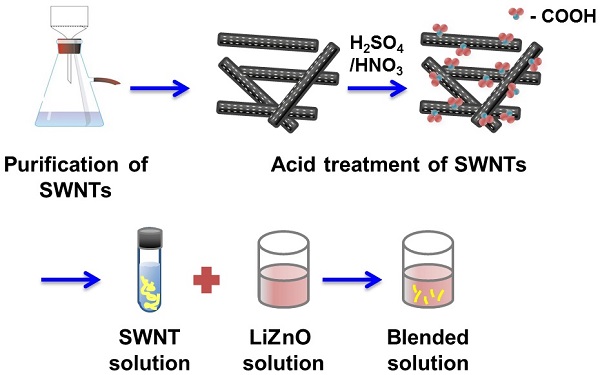Media Center
A multimedia mosaic of moments at GIST
GIST Excellence
[Press Release] Professor Moon-Ho Ham"s research team has developed a high-performance, low-cost thin-film transistor
- 엘리스 리
- REG_DATE : 2016.04.19
- HIT : 792
Well-dispersed carbon nanotubes used to develop
high-performance, low-cost thin-film transistors
Research results published in Small

An actual pictures of the carbon nanotubes functionalized with lithium-doped zinc oxide thin film transistor.
From left to right, Professor Moon-Ho Ham, research Gi-Cheol Son, and researcher Sang-Soo Chee.
Because of their high carrier mobility, high optical transparency, excellent chemical stability, and large-area uniformity, solution-processed metal oxide semiconductors were seen as a potential alternative to amorphous silicon and organic materials in thin-film transistors (TFT). However, to increase the field-effect mobilities of the solution-processed metal oxide semiconductors, the rare earth element indium was used as a mobility enhancer. Unfortunately, the use of this very expensive element made the resulting material substantially less cost-effective. Single-walled carbon nanotubes (SWNTs) have also been studied as a mobility enhancer that can be into metal oxide semiconductors, but no research has been conducted into indium-free TFTs using SWNT-doped ZnO channel layers until a method was introduced by a research team led by Professor Moon-Ho Ham of the School of Materials Science and Engineering at the Gwangju Institute of Science and Technology (GIST).
The researchers at GIST used a simple, wet-chemical functionalization method to introduce well-dispersed carbon nanotubes (CNTs) that can form uniform spatial distribution with a subpercolation characteristic in thin oxide semiconductor layers. The resulting well-dispersed CNTs improved the electrical properties in lost-cost metal-oxide based TFTs by a factor of 4.8 compared to that of SWNT-undoped LiZnO TFTs.

Photographs showing the dispersion stability of pristine SWNT and
COOH-SWNT aqueous solutions and a graph showing the field-effect mobility.
The research entitled "Chemically Functionalized, Well-Dispersed Carbon Nanotubes in Lithium-Doped Zinc Oxide for Low-Cost, High-Performance Thin-Film Transistors" was authored by Gi-Cheol Son, Sang-Soo Chee, Ji-Hyun Jun, Myungwoo Son, Sun Sook Lee, Youngmin Choi, Sunho Jeong, and Moon-Ho Ham and was published in Small on February 9, 2016.
The research was supported by Global Frontier Program through the Global Frontier Hybrid Interface Materials (GFHIM) of the National Research Foundation of Korea (NRF) funded by the Ministry of Science, ICT & Future Planning, Basic Science Research Program through the National Research Foundation of Korea (NRF) funded by the Ministry of Education, and Basic Science Research Program through the National Research Foundation of Korea (NRF) funded by the Ministry of Science, ICT & Future Planning.

Schematic illustration showing the sequential procedures
for preparing blended solution of COOH-SWNTs and LiZnO.
Professor Moon-Ho Ham said, "It is expected that the methodology suggested in this study will open up a new pathway for realizing the high-performance, cost-effective, large-area electronics based on metal oxides, such as ultra-high definition tv, smartphones, as well as flexible devices such as smart watches."